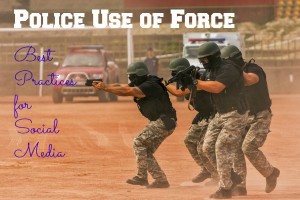
Over the last several years, officer use of force incidents have become the center of attention across the United States. With the widespread use and availability of video, hardly a day goes by that a police use of force incident is released to the public. Video recorded on cell phones has become the norm and as more and more police agencies begin using body worn video, this trend will continue to expand.
Once you have an officer use of force incident, especially if it is a shooting, all of the attention of the community, media and social media will laser focus on the officer. Numerous parties will dissect his or her life, work history and personal opinions. The media, the public, and haters across the globe will search for any information they can find, hoping to get more information about the officer in question. Some of these individuals searching hope to confirm some predisposed opinion of the officer that may or may not match the reality of the incident under scrutiny.
Three precautions can be taken to help protect an officer if he or she is ever involved in a use of force incident that garners such widespread attention.
1. USE MOM AS A YARDSTICK
This one is self-explanatory. Police officers have a responsibility to be fair and impartial, and are held to a much higher standard than the public or almost any other profession. In order to make sure that standard is upheld, it is important not to post anything on personal websites or any social media platform that would reflect negatively on the officer or his or her department.
In other words, post nothing that depicts an officer in any compromising position that could lead to questioning the officer’s ethics. In addition, posts that might be interpreted as sexist, racist, bias, homophobic or any number of other conditions should be avoided.
2. SECURITY SETTINGS
To protect an officer’s privacy, the security settings of his or her social media accounts should be set to the most private settings available. Of course, this setting will not totally protect the account, but it will make it harder for those individuals that don’t know the officer to access his or her posts.
No security setting is perfect…..please refer to using mom as a yardstick.
3. DEPARTMENT SOCIAL MEDIA POLICY
By now, every law enforcement agency should have a social media policy that provides guidelines for each officer that uses social media for their agency or personally. A well-written social media policy can serve as a guideline for officers to help remind them of the high standard expected in their personal and professional lives.
Police officers still have their First Amendment rights. However, those rights are not absolute and can be restricted more than some professions based on the nature of the job of a police officer.
Following these three guidelines closely will reduce the risk of something negative being found on an officer’s social media account after an officer use of force incident. However, even the most conscientious officer could become victimized under the right circumstances. Therefore, take the following additional step once there is an officer involved use of force incident that is likely to attract widespread attention.
DELETE ALL PERSONAL SOCIAL MEDIA ACCOUNTS
Before the name of the police officer involved in a use of force incident is released, the officer should delete every social media account he or she has. Just because the accounts are deleted does not mean all of the data is gone. Instead, it will make it a little harder for those trying to dig up information on the officer to find it.
Deleting the accounts will also protect the officer from all the haters who might attack the officer online once his or her name becomes known.
If the department has a good policy, the officer has set his or her privacy settings up correctly and conducted himself or herself as a professional while online, the risk of any problematic issues will be mitigated. Nevertheless, it is important to take all the precautions’ possible and delete all of the social media accounts of the officer involved in a police use of force incident.
This post was originally published on February 22, 2016 on Chief Grogan’s blog.